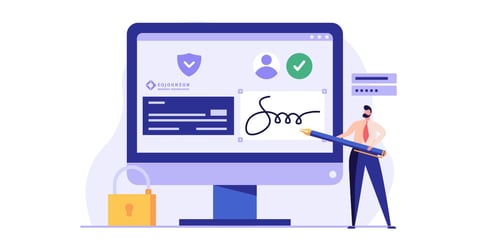For many businesses, training materials still live in thick binders, outdated folders, or stacks of paper tucked away in filing cabinets. These paper training manuals often create logistical headaches, make updates difficult, and slow down workforce enablement. In an increasingly digital business environment, relying on outdated formats for onboarding and training can hinder productivity and increase long-term costs.
Digitizing training manuals is a powerful way to modernize your employee development processes. By converting paper training manuals into digital training manuals, organizations can significantly improve efficiency, boost accessibility, and maximize ROI while setting the stage for HR process automation and smarter employee engagement.
The hidden cost of paper training manuals
It's undeniable that paper-based training manuals have served their purpose over the years. However, they come with a variety of hidden costs that can't be overlooked:
- Storage and retrieval issues: Physical manuals take up space and can be hard to locate when needed.
- Version control problems: When updates are needed, it's difficult to ensure every employee has the latest version.
- Limited accessibility: Employees must be physically present to access the material, which can create friction for hybrid or remote teams.
- Print and distribution expenses: Printing and distributing manuals across multiple locations is time-consuming and costly.
When you multiply these inefficiencies across departments and locations, the impact on your bottom line becomes clear.
Why digitizing training manuals makes sense
Digitizing training manuals removes the bottlenecks created by physical materials and empowers your HR and training teams to operate more efficiently.
1. Improved efficiency and workflow
A digitized manual can be indexed, searchable, and integrated into a document management system or HR platform. This allows for faster onboarding and more streamlined access to job-specific procedures.
Digital training manuals also reduce manual administrative work. Instead of printing, assembling, and distributing binders, HR teams can upload a single file to a secure portal or learning management system (LMS), saving hours of manual effort.
2. Accessibility for a distributed workforce
Accessibility is crucial for supporting hybrid and remote work. Digital training manuals can be accessed anytime, anywhere - from laptops, tablets, or mobile devices. This level of flexibility helps new hires onboard more quickly, regardless of location. Even legacy materials can be available to employees with just a few clicks.
3. Better ROI and lower long-term costs
While there is an upfront cost to digitizing your paper training manuals, the return on investment is often substantial. Once digitized, materials no longer need to be reprinted or physically updated. Digital formats allow for easy edits and instant redistribution, reducing future costs while speeding up training delivery.
Companies also experience fewer errors and less downtime due to outdated or inaccessible training documents. That translates directly to productivity gains and fewer interruptions in daily operations.
4. Support for HR process automation
Digitized training materials can easily be integrated into broader HR process automation initiatives. For example, when onboarding a new employee, automated workflows can trigger the delivery of job-specific training materials, track completion, and log acknowledgments - all without manual intervention. This level of automation not only reduces overhead for HR teams but also provides better visibility into employee progress and compliance.
5. Enhanced compliance and security
In regulated industries, maintaining up-to-date training records is essential. Digital training manuals can be version-controlled and tracked, with audit trails showing when updates were made and who accessed the information.
By digitizing, businesses also reduce the risk of lost or damaged physical manuals, improving both compliance and document security.

Workforce enablement that scales
Digitizing training manuals directly supports workforce enablement and employee empowerment by giving employees the information they need when and where they need it. Whether onboarding new hires, training employees on new systems, or ensuring regulatory compliance, digital training manuals are easier to update, distribute, and track.
Organizations that embrace digitization report faster onboarding cycles, improved employee confidence, and stronger adherence to internal policies - all of which contribute to better business performance.
Don’t wait to digitize
The longer your company relies on paper training manuals, the more you risk inefficiencies, compliance challenges, and increased overhead. Modernizing your training materials is a foundational step in transforming your business into a more agile, responsive organization.
EO Johnson’s bulk document scanning services make it easy to convert your paper training manuals into efficient, accessible digital assets. We use high-speed scanning and indexing tools to ensure your materials are digitized quickly, securely, and ready for integration into a new document management system or your existing platforms. Let’s turn your paper training manuals into a powerful digital resource.







